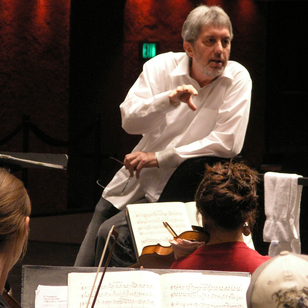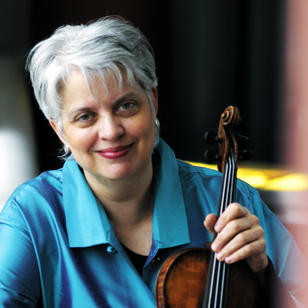FOR IMMEDIATE RELEASE
Oct. 14, 2013

Conductor Cliff Colnot works with Jacobs School of Music students.
BLOOMINGTON, Ind. – The Indiana University Jacobs School of Music presents an in-depth view into the creation of Beethoven's Fifth Symphony as it presents the "Beethoven Fifth Project: Behind the Score," including several free public events this month.
The University Orchestra's performance study of Beethoven's Symphony No. 5 in C Minor, Op. 67, will culminate in a performance conducted by guest Cliff Colnot and a behind-the-scenes video of the learning process of the work at 8 p.m. on Wednesday, Oct. 30, in the Musical Arts Center.
Colnot, who will lead the orchestra throughout the project, is director of orchestral activities and wind ensemble conductor at DePaul University. He is also principal conductor of the Chicago Symphony Orchestra's contemporary MusicNOW ensemble and principal conductor of the Civic Orchestra of Chicago.
"The notion that we can study a major work of the orchestral canon in great detail, understanding the history, theory and form is a great opportunity for all involved," said Colnot. "I think it is an absolutely terrific idea."
In addition, musicologist Richard Kramer, distinguished professor at the City University of New York Graduate Center, will present the lecture "Composing the Fifth: Beethoven at Work" at 4 p.m. on Monday, Oct. 21, in Room 036 of the Musical Arts Center. The talk is sponsored by the Jacobs School of Music Lecture Series.
Director Abel Gance's 1937 film "Un Grande Amour de Beethoven" ("Beethoven’s Great Love") will be screened at 6:30 p.m. on Sunday, Oct. 27, in Sweeney Hall. The 135-minute classic French film stars Harry Baur in the title role.
The "Beethoven Fifth Project: Behind the Score" is the brainchild of project director Jorja Fleezanis, Jacobs professor of violin and Henry A. Upper Chair in Orchestral Studies.
She was inspired by a trip to Bonn, Germany, with the Jacobs student Wasmuth Quartet last spring, during which the members immersed themselves in the study of manuscripts by Beethoven at the Beethoven-Haus, a museum dedicated to the master composer, and performed a concert at the Villa Wasmuth (from which the ensemble took its name).

Project director Jorja Fleezanis
"The trip to Bonn was life changing," said Fleezanis. "It seemed to me that such an immersive experience should not be restricted to just there, and I began to think of the whole subject from a much broader perspective. I wanted to facilitate giving students material beyond just the notes and attempt to synthesize performance, historical and scholarly aspects. Most of the time, those things live separately from each other."
Fleezanis said she then contacted Colnot, who was already scheduled to work with the orchestra, and he was very excited about the idea of creating a crossroads for departments that are dependent upon each other but often exist in isolation from one another.
"It is very gratifying to promote interaction and to tie together some of the vast expertise within the Jacobs School of Music," said Fleezanis. "The more ingredients, the more nutrients."

